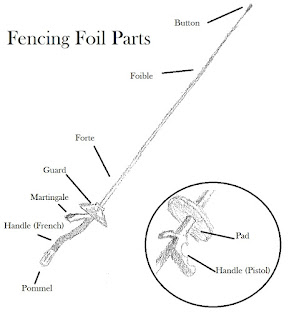Fencing has been part of society since the 12th
century and made its way from the original Greek Olympics to modern Olympics. The foil is the most common fencing sword in
the sport and is generally the first to be learned. Learning foil offers the
development of basic style, skill, and game mechanics that are unlikely to come
from saber or epee. Knowing the parts of the foil is important for grasping how
it becomes an extension of one’s body.
The foil is made of light steel between 350g and 500g. The
length cannot be longer than 90cm. I have both a 350g and a 500g blade (1). There are
significant differences in the weight and strength. At 500g your
movement is likely to be mooted as the weight slows down a quick reaction.
It does afford the ability to overpower your opponent in parry and riposte but
you are unlikely to be nimble enough to counter a skilled opponent’s moves. Furthermore,
a heavy blade will fatigue your arms in long bouts and give your opponent an
advantage.
The blade is made from low-carbon steel which allows it to
bend upon striking its opponent. Due to the potential injuries associated with
the use of metal equipment a mask and protective suit is worn. Even with this
equipment fencing can leave some nasty bruises caused during the heat of the
game. Blades can get broken and egos can get damaged. A solid piece of wisdom is
to never turn your back on your opponent because you never know when someone
will strike you in the back-as terrible as it sounds....it happens.
Parts of the Foil
Pommel: Fastens the foil together.
Grip: Comes in pistol or French.
Bell Guard: Protects the hands.
Forte (Strong): Heavy part of blade.
Medium: Medium part of the blade.
Blade: The entire blade (90 cm).
Foible (Weak): Bendable part of blade.
Button: The protective tip on the foil.
Other Reading:


